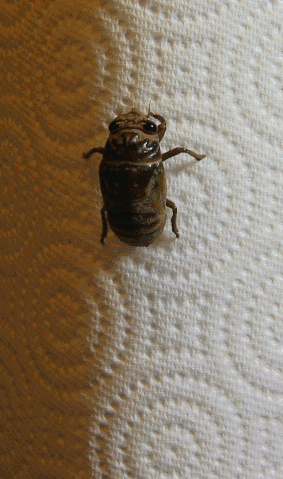Imago facts for kids
The imago is the final stage in the life of an insect. Think of it as the fully grown, adult version of an insect!
For insects that go through an incomplete metamorphosis (like grasshoppers or dragonflies), the imago appears after their last molting (shedding their skin). If an insect has a complete metamorphosis (like butterflies or beetles), the imago emerges from the pupa stage.
This is a super important stage because it's the only time the insect is ready to reproduce. Also, if the insect species has wings, this is when they are fully formed and ready for flight!
Contents
What is an Imago?
The word "imago" comes from Latin and means "image" or "likeness." In the world of insects, it refers to the final, adult form. This stage is all about being ready to start the next generation of insects.
Insect Life Cycles
Insects grow and change in amazing ways, a process called metamorphosis. There are two main types:
Incomplete Metamorphosis
Some insects, like grasshoppers, crickets, and dragonflies, go through incomplete metamorphosis. Their life cycle has three main stages:
- Egg: The life starts as a tiny egg.
- Nymph: The egg hatches into a nymph. A nymph looks a lot like a smaller version of the adult, but it doesn't have fully developed wings or reproductive organs. As it grows, it molts (sheds its outer skin) several times.
- Imago: After the last molt, the nymph becomes an imago. It's now a fully grown adult with working wings (if it's a winged species) and is ready to reproduce.
Complete Metamorphosis
Other insects, like butterflies, moths, beetles, and flies, go through complete metamorphosis. Their life cycle has four distinct stages:
- Egg: The life begins as an egg.
- Larva: The egg hatches into a larva. This stage is often called a caterpillar (for butterflies), a grub (for beetles), or a maggot (for flies). Larvae are usually focused on eating and growing a lot! They look very different from the adult insect.
- Pupa: After growing enough, the larva changes into a pupa. This is a resting stage where the insect transforms inside a protective casing (like a chrysalis for butterflies or a cocoon for moths).
- Imago: Finally, the imago emerges from the pupa. This adult insect looks completely different from the larva and is ready to fly and reproduce.
Why the Imago Stage Matters
The imago stage is super important for several reasons:
- Reproduction: This is the only stage where insects can mate and lay eggs, ensuring their species continues.
- Dispersal: Many adult insects have wings, allowing them to fly long distances. This helps them find mates, new food sources, and new places to live, spreading their species to different areas.
- Survival: The adult form is often designed for specific tasks like feeding on nectar (butterflies) or hunting (dragonflies), which helps them survive and reproduce successfully.
See also
 In Spanish: Imago (zoología) para niños
In Spanish: Imago (zoología) para niños


